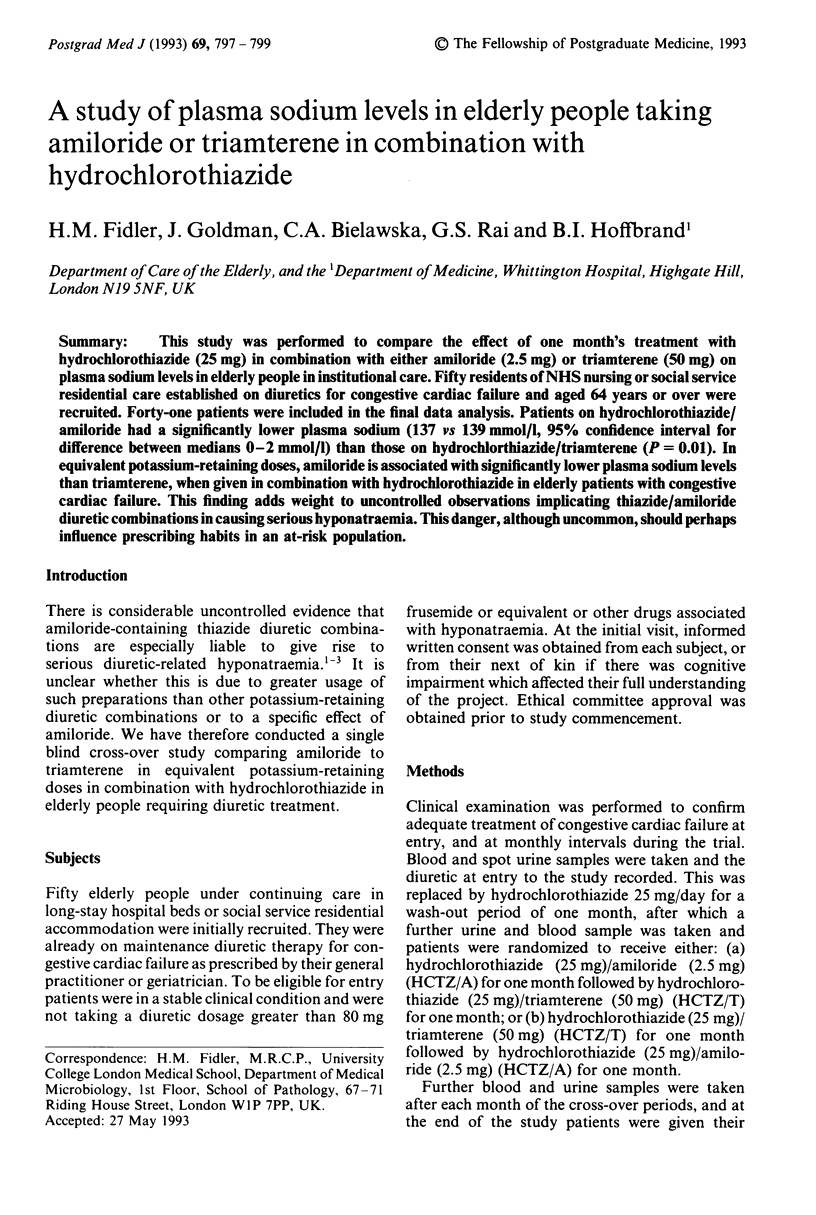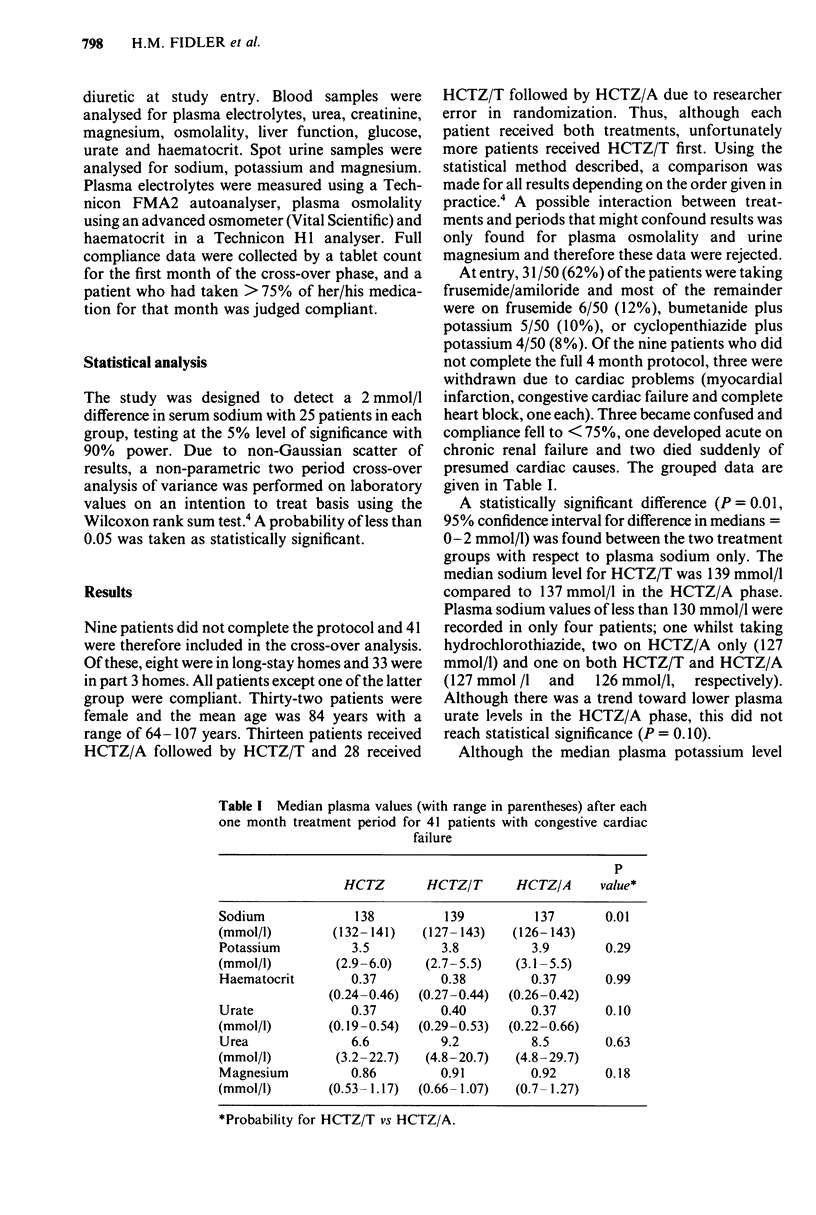Abstract
This study was performed to compare the effect of one month's treatment with hydrochlorothiazide (25 mg) in combination with either amiloride (2.5 mg) or triamterene (50 mg) on plasma sodium levels in elderly people in institutional care. Fifty residents of NHS nursing or social service residential care established on diuretics for congestive cardiac failure and aged 64 years or over were recruited. Forty-one patients were included in the final data analysis. Patients on hydrochlorothiazide/amiloride had a significantly lower plasma sodium (137 vs 139 mmol/l, 95% confidence interval for difference between medians 0-2 mmol/l) than those on hydrochlorthiazide/triamterene (P = 0.01). In equivalent potassium-retaining doses, amiloride is associated with significantly lower plasma sodium levels than triamterene, when given in combination with hydrochlorothiazide in elderly patients with congestive cardiac failure. This finding adds weight to uncontrolled observations implicating thiazide/amiloride diuretic combinations in causing serious hyponatraemia. This danger, although uncommon, should perhaps influence prescribing habits in an at-risk population.
Full text
PDF


Selected References
These references are in PubMed. This may not be the complete list of references from this article.
- Batlle D. C., von Riotte A. B., Gaviria M., Grupp M. Amelioration of polyuria by amiloride in patients receiving long-term lithium therapy. N Engl J Med. 1985 Feb 14;312(7):408–414. doi: 10.1056/NEJM198502143120705. [DOI] [PubMed] [Google Scholar]
- Bayer A. J., Farag R., Browne S., Pathy M. S. Plasma electrolytes in elderly patients taking fixed combination diuretics. Postgrad Med J. 1986 Mar;62(725):159–162. doi: 10.1136/pgmj.62.725.159. [DOI] [PMC free article] [PubMed] [Google Scholar]
- Byatt C. M., Millard P. H., Levin G. E. Diuretics and electrolyte disturbances in 1000 consecutive geriatric admissions. J R Soc Med. 1990 Nov;83(11):704–708. doi: 10.1177/014107689008301111. [DOI] [PMC free article] [PubMed] [Google Scholar]
- Ghosh A. K., Mankikar G., Strouthidis T., Windsor A., Long C., Glover D. R. A single-blind, comparative study of hydrochlorothiazide/amiloride ('Moduret' 25) and hydrochlorothiazide/triamterene ('dyazide') in elderly patients with congestive heart failure. Curr Med Res Opin. 1987;10(9):573–579. doi: 10.1185/03007998709112410. [DOI] [PubMed] [Google Scholar]
- Mathew T. H., Boyd I. W., Rohan A. P. Hyponatraemia due to the combination of hydrochlorothiazide and amiloride (Moduretic): Australian spontaneous reports 1977-1988. Med J Aust. 1990 Mar 19;152(6):308–309. doi: 10.5694/j.1326-5377.1990.tb120954.x. [DOI] [PubMed] [Google Scholar]
- Medical Research Council trial of treatment of hypertension in older adults: principal results. MRC Working Party. BMJ. 1992 Feb 15;304(6824):405–412. doi: 10.1136/bmj.304.6824.405. [DOI] [PMC free article] [PubMed] [Google Scholar]
- Scoble J. E., Varghese Z., Sweny P., Moorhead J. Renal physiology revisited: amiloride. Lancet. 1986 Aug 9;2(8502):326–328. doi: 10.1016/s0140-6736(86)90013-9. [DOI] [PubMed] [Google Scholar]
- Sunderam S. G., Mankikar G. D. Hyponatraemia in the elderly. Age Ageing. 1983 Feb;12(1):77–80. doi: 10.1093/ageing/12.1.77. [DOI] [PubMed] [Google Scholar]


